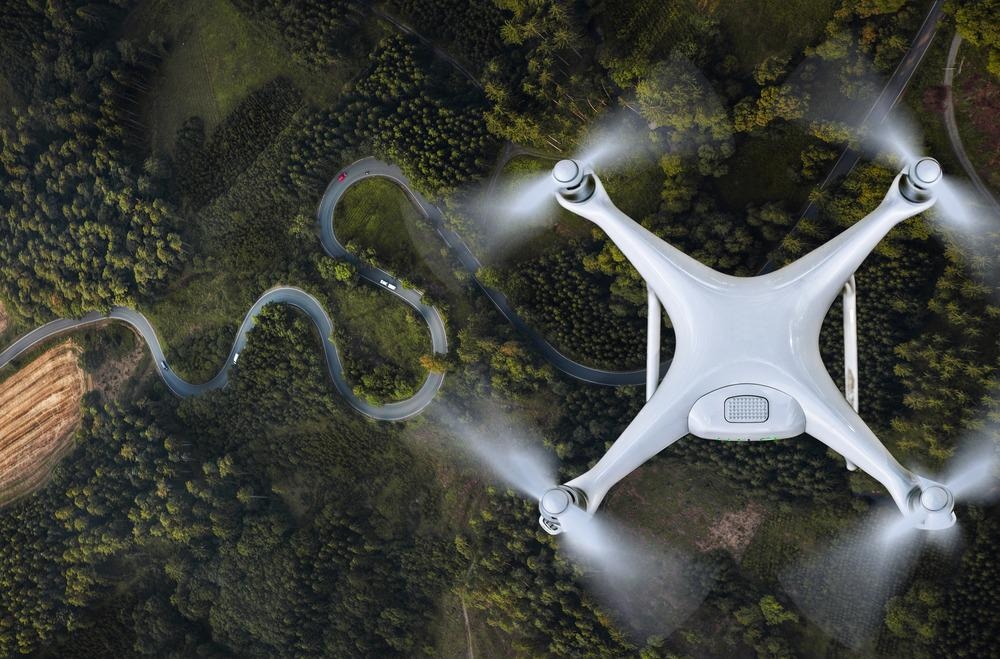Amazon and Wing Aviation (owned by Alphabet, Google’s parent company) both recently got the US government’s go-ahead to start using drones for commercial delivery. An ex-Uber employee recently unveiled his start-up, Whisper Aero, which is developing technology to reduce the risks of noise pollution that this rise in local air traffic poses.

Image Credit: Rocksweeper/Shutterstock.com
Almost all the major companies in the logistics, ecommerce, food and transportation industries are looking to the skies to get their products to customers. Electric vertical take-off and landing (eVTOL) passenger aircraft are poised to start providing the local taxi services that Uber and Lyft have so quickly capitalized on.
So far, little attention has been paid to the noise pollution risks that all this extra air traffic activity poses. Mark Moore, who previously ran Uber’s air taxi division and is a former NASA engineer, saw this as the unexplored potential for new developments in electric propulsion systems for flight.
Unveiling Whisper Aero
Moore left Uber Elevate when the division was acquired by Joby Aviation, and launched his own company, Whisper Aero.
The company is developing an electric thruster that blends the noise emitted from delivery drones and eVTOLs into background levels. This makes them almost imperceptible to the human ear. This product will be adaptable for all kinds of electric propulsion systems for flight.
Moore had been mulling over the idea behind this company for years, alongside the firm’s COO Ian Villa who also used to work at Uber Elevate. The two realized years ago that reducing propulsion noise was vital for the public and regulatory bodies to accept air taxis in the future.
The pair believe that noise is the main barrier to air taxis’ adoption but saw that not a lot of focus was put on reducing noise levels in the main developers’ plans.
The company is developing a thruster that will help to reduce noise levels for all kinds of air traffic. It says the technology also has applications for making land-based systems work more quietly. Beyond this, however, the company has released scant information on how its noise reduction system works.
In any case, it has attracted around $7.5 million of investment so far.
Loud Sky: The Dangers of Noise Pollution
Small recreational drones are already loud enough to bother people, especially when away from the background noises of traffic, construction, and millions of other humans in an urban environment.
The drones that Amazon and Wing Aviation will use are enormous and much louder. Like recreational drones common today, they also have high frequencies caused by the very high speeds their rotors need to spin at.
Swarms of drones in the sky – alongside fleets of eVTOL air taxis – will also all have slightly different frequencies. This means that the noise they make together will be even more annoying to humans – and potentially threatening to local ecosystems.
According to a recent US government study, eVTOL rotors generate more “broadband” noise than helicopters, which generate “tonal” noise. Broadband noise is harder to block out than tonal noise and may be more irritating.
NASA recently found that drone noise is more annoying to people than traffic noise. However, they postulated that this could be because people were already used to hearing traffic noise, and their brains had learned to disregard it.
Joby Aviation and other eVTOL companies like them, Moore points out, are already invested in low-volume aircraft technology.
Amazon and the other delivery companies will meet opposition from the public and regulatory bodies if the noise issue is not quickly dealt with. NASA researchers even argued that drones that are no louder than trucks and cars will not be accepted by the public.
Working to reduce the risk of noise pollution has wider benefits than easing public acceptance of drones and eVTOLs. Studies have clearly shown that noise exposure is a health risk. It can cause hearing impairment, hypertension, heart disease, and disturbed sleep.
Next Steps for Whisper Aero
Whisper Aero is on a path to minimize this risk and is seeking to position itself at the forefront of acceptably quiet electric propulsion systems for flight. Its provisional patents are due to be converted with the US patent office in 2022.
It will then launch in the small drone market in 2023, according to the company’s forecasting. From there, the company will progressively scale the technology up until it can be applied to air taxis.
By the end of the 2020s, the company hopes to be manufacturing thrusters and vehicles. This would see them enter the second generation of eVTOL transport if forecasts for first-generation technology by 2024 are accurate.
The remaining technical challenges still need to be ironed out for Whisper Aero, not least of which is finding a manufacturing process that achieves acceptable levels of cost. Dynamic testing in a wind tunnel as well as static tests with US government hardware in Tennessee are next on the cards.
References and Further Reading
Alamalhodaei, A. (2021) Whisper Aero emerges from stealth to quiet drones and air taxis. [Online] TechCrunch. Available at: https://techcrunch.com/2021/07/12/whisper-aero-emerges-from-stealth-to-quiet-drones-and-air-taxis/
Christian, A., and R. Cabell (2017) Initial Investigation into the Psychoacoustic Properties of Small Unmanned Aerial System Noise. [Online] NASA Technical Reports Saver. Available at: https://ntrs.nasa.gov/citations/20170005870.
Paine, G. (2019) Drones to deliver incessant buzzing noise, and packages. [Online] The Conversation. Available at: https://theconversation.com/drones-to-deliver-incessant-buzzing-noise-and-packages-116257
Passchier-Vermeer, W. and W. F. Passchier (2000) Noise exposure and public health. Environmental Health Perspectives. https://dx.doi.org/10.1289%2Fehp.00108s1123
Disclaimer: The views expressed here are those of the author expressed in their private capacity and do not necessarily represent the views of AZoM.com Limited T/A AZoNetwork the owner and operator of this website. This disclaimer forms part of the Terms and conditions of use of this website.